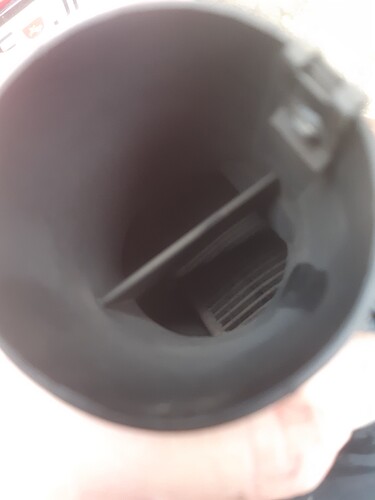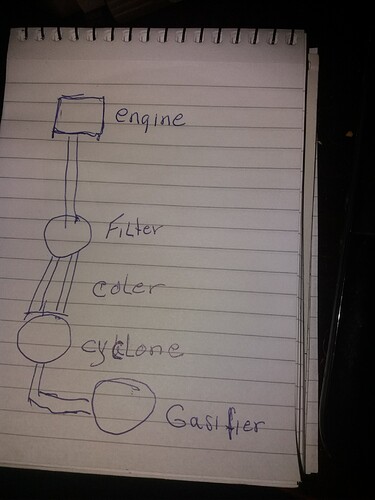Do you think it is worth making a cyclone and installing it in a gas cleaning system? How much more benefit than harm will its presence do? 
Hello Joni .
I think the less restriction the air flow going to your motor the better . It must breathe easy to have good performance . It seems no matter what type filter there will be some amount of restriction of the air flow. For a cyclone to function properly at a high air velocity it also will cause some restriction of the air flow .
Maybe a question to ask . Does soot getting into the motor cause any problems or damage ? ( not to be confused with tar )
Wayne,
a cyclone of soot will not catch no matter how you want it … 
I just wanted to analyze the messages of this audience about the efficiency of gas cleaning and braking.
Cyclones 




Range use limiters.
Flow slowing intentional settlement/dropping out areas 




S.U.
Complex topic. Depends, charcoal or wood. For charcoal in short, l think a “slow” cyclone, just to get coarse dust out with barely any restriction, folowed by a sack filter is best combination. Gas is preety much 100% clean and dry.
For wood, l had good resaults with just passing the COOL gas trugh 2 small cyclones in paralell. NO aditional filtering. A lot of water droplets together with all the big its, dust and some soot was extracted. But most soot still passed, wich, as Mr Wayne hinted, seems to be harmless to the motor.
Passing woodgas trugh a “fast” cyclone then trugh aditional filters just doesent make sence to me. Except the goal is allso to extract heat (cyclones are great at that) or some other benefit one wants, like space conservation. Every system is different…
For charcoal just dont put dust in the gasifier and you dont need a cyclone. A bag filter is all that is needed then.
On a wood gasifier I exhaust the gas up higher than the grate to let the dust drop out and I also pull out along the side for a mild vortex to give the gas longer dwell time. That dust in the right filter can actually be part of the filtering process. A bag filter for instance as the dust collects it becomes the filter media. The dirtier it gets the better it filters. Bag filter are very passive compared to any other filter types. This is for dust.
For any liquids filtering you do not use a media filter, that is for filtering debris not fluids. In our producer gas, all liquids are carried in the gas in gas suspension and are dropped throughout the entire filtering process and most likely beyond it and into the engine. This is a refining process and you are dropping different grades and components of the gas that initially left the grate of your gasifier. First stage is mostly water, then soot, and all sorts of grades of tar. Thicker tar in early stage and engine damaging valve gluing thinner tars in the later stages. When liquids are concerned you use a condensing process. you do not need media here, when you hit due points those components will drop like rain immediately. Just because you might see tar in your filter does mean its filtering;; yup some just dropped there and it caught it. But if it were actually filtering tar it would clog up in a heart beat.
Hello Wayne!
Have you measured the resistance of the gasifier filters?
Fog, fog, fog. Every day. Its miserable! Things started to fail from moisture. So did my trusty Seat. It stood for a couple of days, today only hit on one cylinder. Looked under the hood, all driping wet from the fog. The car is 22 years old, still has its first ignition cables probably. So its understandable they leak sparks in such weather.
Anyway, this is a good opertunity to show you guys how nicely charcoal gas can be cleaned useing nothing but a bathroom towel.
The Seat isnt charcoal powered anymore since l got kids (allmost 6 years) and it still has the original air filter l used way then.
The gas went from the gasifier trugh a small cooler then to a towel filter, mixed with air then went trugh the original paper filter. You can see on the picture the many miles l drove on charcoal obly just stained the white paper filter. When chooseing a filtration media for charcial gas, a good old simple towel is just hard to beat!
Hello nvvizm .
As I am driving I view gauges through my rear view mirror . These gauges show the resistance of the filter plus the resistance on the whole gasifier system .
One gauge is between motor and filter . This gauge show vacuum the motor is pulling at any given time .
2ed gauge shows vacuum loss after the flow has ran through the filter system , condensation /dropout tank and cooling system .
3ed gauge shows vacuum loss after the flow has gone through complicated heat exchange , char bed and air nozzles.
Whatever vacuum the first gauge shows the 2ed should show one half .
3rd gauge should read 1/3 of what 2ed gauge shows .
Ok Wayne!
Can you remember the numeric values for sensor 1?
Hello nvvizm .
If I were cruising flat road with dakota truck at about 120 km/h I would expect to read negative 30 inch h2o on 1st gauge
2ed gauge 15
3rd gauge 5
Ok Wayne!
Is 60 inches on gauge 1 a lot?
Hello nvvizm
Only if wide open throttle and a lower gear.
On the below video at 1:10 it will show # 2 gauge going up mountain 30 inches vacuum until higher gear and it goes to 15 inches and speed goes on up to 140 kl/h .
Hello Wayne,
wow !!! 140 is a lot !!! 


 . What is your engine size?
. What is your engine size?
I know you are talking about fuel other than Charcoal but in about 24 hours run time on my charcoal unit I have only collected clear water at the bottom of the cyclone. No dirt or dust. I wouldn’t go to the trouble of building a cyclone again. I’m sure the condensate could be easily captured in the bottom of the filter housing.
Hello Joni and thanks for the compliment .
On little trucks the motor size is 5.2 L
The truck motor is still pulling good at 4000 rpm and has high gearing . Just a little down hill grade I can go 160 kl/h but dare not post it .
The below video cost me over $500 including higher insurance rates 
Hello Tom!
How did you calculate the cyclone?
Can you show your gasification system?
I’ll call you Vlad. I don’t know how to link posts but my whole build is shown if you click the three lines at the top and click projects. Mine is TH charcoal project. I had an old twin tank air compressor so I cut the tanks apart and used one as a water reservoir and the other to make a cyclone out of by bending some aluminum coil stock into a cone and fitting it inside the tank.
Ok Tom!
I have calculated the cyclone from the ‘Handbook of Biomass Downdraft Gasifier Engine Systems’ page 76, fig. 8-5 and am very pleased with its performance.



